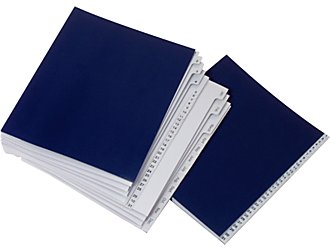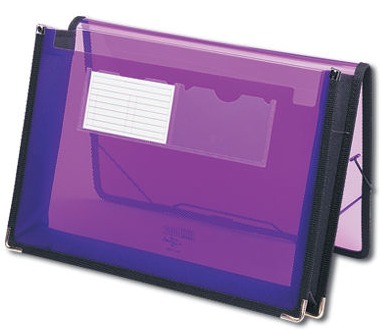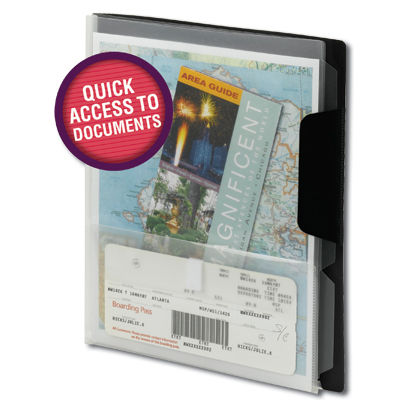Organize Your Travel Documents
Last month, I traveled to the MARCPO conference and then enjoyed a vacation up the Eastern seaboard, traveling from Washington, DC to Providence, Rhode Island to Boston and Salem, Massachusetts. During that time, I took four airplanes, two airport shuttle vans, one car and multiple subway trains. In ten days, I stayed in four hotels in three cities. It may seem like a shocking confession for the 21st century, but I navigated them all without benefit of a smart phone or tablet.
Keeping track of travel information these days seems made for digitization. Nifty apps can replace piles of paper printouts. But should they? On the morning of my return flight, a flustered man stood in front of me in the security line, unable to show his boarding pass because he couldn’t get his cell phone to boot up. Power outages, cell phone tower outages, lost chargers, dead gadgets, limited or intermittent web access — they can all wreak havoc with your travel plans if you don’t have a paper alternative.
I strongly recommend the following basic steps for organizing your travel documents and information to minimize any potential catastrophes.
1) Gather and isolate documents as they arrive. As you make your travel arrangements, print out the confirmations, the bar-coded and QR-coded passes, and any other items you need. Collate them and tuck them away in your tickler file for the day your trip is set to start.

2) Use the belt-and-suspenders approach. Yes, you should print your documents, but there’s no reason not to keep electronic copies, too. Convert each confirmation email or web page to PDF, then back it up in any of a variety of ways. Send it to your Kindle or other e-reader. Save it in a Dropbox or Evernote folder marked with the trip name. Email it to Gmail or another web-based account.
For a lower-tech option, snap photos of your documents with your phone or camera. If necessary, access data using the zoom function to get a close-up on whatever you need.
3) Arrange essential documents in the order in which you WILL need to access them.
- Airline tickets and boarding passes — Printing your boarding pass in advance of your flight allows you to bypass lines at check-in and ticketing kiosks. At larger airports, just give your checked luggage (if you have any) to the Skycap, and you’ll be on your way. Even at airports where you need to check your luggage inside the airport, having your tickets and boarding pass available in advance will expedite the process.
- Special air travel documents — If you are recently married and your honeymoon arrangements were made in your new name, but your photo ID lists your maiden name, having a copy of your marriage certificate with you will help things along, especially if you’re traveling internationally. If you’re divorced (or married, traveling without your spouse) and are traveling with your child, or if you are traveling with a child who is not your own (such as a grandchild or your child’s playmate), you will need a notarized Minor Consent Form from a custodial parent.
- Redress number — This is a code granted to certain passengers whose names have been added to the No-Fly list in error. Providing your accurate redress number should eliminate travel difficulties.
- Train reservation tickets/confirmations
- Cruise tickets/confirmation
- Auto rental reservations/confirmations
- Ground transportation (shuttle/car service) reservations/confirmations
- Printed directions or maps if you’re driving yourself
- Subway/commuter train maps and directions
- Hotel reservations/confirmations
- Writing pad for itinerary changes, directions, messages, etc.
Some travel items should be kept separate from your basic travel documents:
- Airport parking ticket — When you arrive at the airport and take your ticket, tuck it into a safe place in your wallet, away from your cash and other items you’ll be rifling through during your trip. (Snap a photo of your parking level/area to find your car easily upon your return.)
- Passport and Visas — These legal documents need to be kept even more securely than the itemized information above. Rather than keeping your passport and visas with your travel information, maintain them on your person with an RFID-blocking, wearable passport wallet.
4) Arrange non-essential documents in the order in which you MAY need to access them.
- Itinerary
- Airline and frequent traveler loyalty contact numbers
- Travel aggregator (e.g., Travelocity, Orbitz) or travel agency numbers
- Credit card company concierge numbers
- Printout of alternative flight options
- Emergency contact numbers at home and at your destination
- Groupons, Living Social, Restaurant.com and other discounts/coupons for dining at your destination(s)
- Envelope for collecting receipts, especially for items that will need to be expensed/reimbursed, checked against a bank or credit card statement, or needed for tax purposes.
5) Contain documents in a translucent document organizer.
Certainly, you could maintain your travel documents in traditional file folders or kraft envelopes. They aren’t optimal, however, because you have to open them to see anything, even the very next item you’ll need, and each opening of the file or envelope risks loss and items fluttering to the ground.
The trick with a see-through travel document organizer is to have the items you know you’ll need in “front,” with the items you may need, located at the “back.” Place the stacks of the two types of items back-to-back. Then, just flip over the whole document organizer, and your itinerary will be easy to read without removing it from the organizer, while items behind the itinerary can be easily accessed should they become necessary.
In the twelve minutes between when I confirmed that my flight to DC was on time and the moment I’d entered the airport, soaking wet, after parking in the last available airport parking spot, my flight had been canceled due to mechanical difficulties. The rumor among the equally-soaked passengers was that we’d be boarded onto a bus to take us to a nearby city’s airport. That option would certainly have caused me to miss my connection.
Flipping my translucent document organizer over, I perused the items in the back. Behind my itinerary, the next two sheets provided what I wanted — Delta Skymiles’ direct number and Travelocity’s schedule of other flights to my destination. In what almost seems miraculous in this age of grumpy traveling, well before I’d reached the head of the line, I’d been rebooked for a flight that got me to my connecting airport only 40 minutes later than originally planned, tidily making my connection. Meanwhile, people who had been ahead of me in line, frantically shuffling and dropping papers, were delayed up to eight hours.
So, Paper Doll is a big proponent of using translucent poly envelopes or pockets to corral travel documents. Some excellent options include:
Smead Poly Wallets are highly durable, four-sided, reinforced wallets which repel moisture, resist tears and hold up to 200 letter-sized sheets.

They come in blue, green and purple, are highly visible and are unlikely to blend in with your surroundings and be left behind. The poly wallets can expand up to 2 1/4″, and feature sewn fabric trim, heavy-duty black cloth gussets, a protective cover flap and an elastic cord for securing the corners. In addition, the wallets have two clear pockets on the front for positioning business cards or keeping emergency information easily accessible. You can clearly read the documents within.
Pendaflex’s Oxford Storage Envelope Plastic Tab Dividers offer a simple but elegant alternative. Coming in packs of three colored envelopes (red, blue and yellow), each with one of three tab positions, these pockets have a fold-over flap with a Velcro dot closure, securing the contents on all four sides. The plastic flap can be closed or tucked inside the envelope to keep it out of the way when you’re flipping through your travel documents.

On the left side (if one holds the envelope vertically), the Storage Envelope Tab Dividers have a three-hole-punched poly extension. Each pocket holds about 50 sheets of letter-sized paper. Use just one pocket for a shorter trip; for a longer one, label the tabs and use individual pockets for each day or leg of your travels. Again, you can read the “top” contents (on either side) right through the Storage Envelope Tab Dividers.
Smead Travel Organizers are made of a clear, acid-free archival polypropylene and have three clear plastic tabbed sheets.

There’s a stiff plastic backing and a Velcro-closure plastic envelope (about the size of a standard #10 envelope) attached to the front divider. The pocket is designed to hold boarding passes and receipts, while itineraries, notes, flat maps and confirmation numbers can be easily slotted in the tabbed pages. To see how it might be customized for your travel needs, take a peek at how Janine Adams of Peace of Mind Organizing personalized her Smead Travel Organizer.
6) Upgrade for extended travels. If you’re going to be traveling for weeks at a time and headed to multiple venues, you might want to consider a three-ring binder and upgrade from standard plastic sheet protectors by using the above-mentioned Oxford Storage Envelope Plastic Tab Dividers.
Or, for creating more categories, look at the Oxford Full-Pocket Plastic Tab Dividers.
These come in packs of five colored pockets (red, orange, yellow, green and blue), each with one of five tabbed positions. The front is clear, while the back of the pocket is translucent colored poly. The pockets are closed along the bottom and left (hole-punched) sides, while the top and right (tabbed) sides are open. A poly corner lock positioned at the juncture of the two open edges keeps documents in place (provided you remember to tuck the corners of your documents underneath it).
Unlike the Storage Envelope Plastic Tab Dividers, the Full-Pocket Plastic Tab Dividers hold only about 20 sheets of letter-sized paper. However, they do feel a bit sturdier than the Storage Envelopes.
Since both styles are already three-hole punched and tabbed, drop them in your binder and color-code for cities/states/countries or use multiple packs, coding red as airlines or blue as hotels at each destination.
Another alternative is the Oxford Pocket Storage Folder with 4 Sliding Pockets. When closed, it appears similar to the Storage Envelopes above, albeit with a larger flap and made of stiffer, more durable poly.

The Oxford Storage Pocket Folder’s divided pockets are clear, while the backing and flap are opaque blue poly. When opened, the four connecting pockets slide apart, vertically as well as in terms of depth, to enable you to view bits of each section simultaneously.
7) Have a human backup. Make sure an always-reachable assistant, BFF or spouse has paper or digital copies of your essential travel information. I always send copies of my trip info to Paper Mommy and to a tech-savvy hero/friend (who blushes if named publicly). So far, so good.
Happy travels!




Follow Me